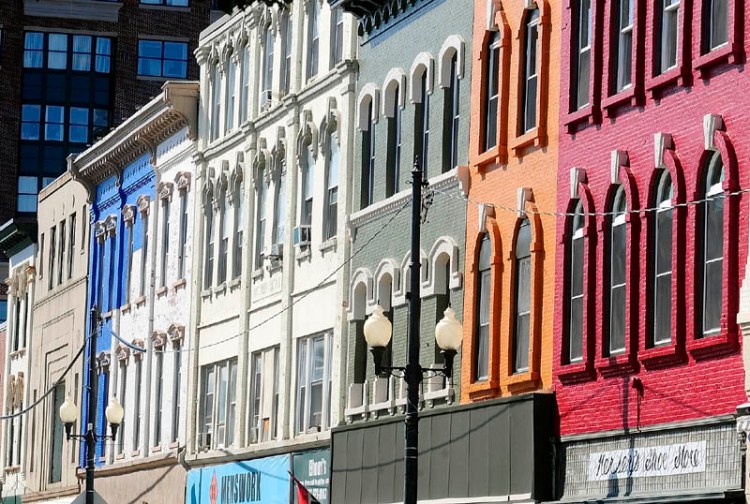The Augusta City Council will soon consider an order to return to two-way traffic in the middle part of Water Street, the heart of downtown, for the first time since 1945, just as the Second World War was ending.
That interesting fact was uncovered by the city’s Planning Department in compiling background materials on the proposed return to a two-way street. The initial move to one-way was made “to speed up the flow of traffic,” according to the Kennebec Journal, reporting that the change would take effect on July 15, 1945. Mayor Sanford Fogg told the Board of Aldermen and the Common Council – Augusta then had bicameral government – that the police chief “feels that it will clear Water Street faster, and I think we should give it a trial.”
The initial one-way street featured angle parking – much as one still sees in downtown Brunswick, where it works well because of the width of the street, and in Wiscasset, where it doesn’t work at all. In the 1970s, Augusta’s perceived need for even greater traffic speeds led to the current Water Street pattern, with parallel parking on both sides of the one-way section.
That was then. The entire context of roads in downtown areas has shifted dramatically since the 1970s. Four decades ago was the height of what we’ve come to know as “sprawl,” which involved the abandonment of downtowns as business and residential centers, and the seemingly endless push of industry, stores and people out into the countryside, fueled by construction of the Interstate Highway System.
In Augusta, the opening of the Maine Turnpike extension from Portland in 1956 necessitated the four-lane Western Avenue we see today. This era saw the construction of three strip malls along the enlarged road, and the inevitable decline of Water Street, as population and tax dollars also shifted to the one-time farming communities surrounding the city.
But a funny thing happened to the suburban impulse, and to the shopping malls and highway congestion that were such a big part of the phenomenon. Starting in the 1990s, downtowns began reviving across America, and urban areas began moving closer together, rather than farther apart.
Augusta, for a time, was still headed in the other direction. The Marketplace at Augusta and, later, Augusta Crossing, both directly accessible to Interstate 95, made the capital a regional retailing center.
Yet the new malls had the effect of siphoning business from the older Western Avenue sites, and two of the three may be available for redevelopment within the next few years. This suggests that the City Council has a major opportunity to redefine the way cars and people co-exist in the city’s center, as clearly they must.
Since Water Street was made one way, the Memorial Bridge, completed in 1949, diverted traffic from downtown, and since 2004, the “third bridge,” carrying Route 3 high over the Kennebec, has taken all the heavy truck traffic away from the city’s core areas. The original rationale for a one-way Water Street has disappeared.
Instead, the rapidly growing downtown movement, from the Colonial Theatre restoration at the north end of Water Street, to the pubs and restaurants springing up at the south end, is based on the idea that downtown will once again focus on pedestrians and their needs, rather than traffic flow.
For this reason, it’s no surprise that most downtown businesses strongly support returning to two-way traffic. It can accelerate the return of Water Street – with first-floor shops and restaurants, and upstairs apartments and offices – to its historic vitality.
The council, and Augusta’s residents and visitors, need to ask how they see the future. If they want a counter-example, they can look at downtown Hallowell, which has seen the conversion from two-way traffic to one way, temporarily, during reconstruction of its Water Street.
Hallowell had the opportunity to enhance its pedestrian focus as part of reconstruction, but settled for a flat, smoother road. Augusta, however, could accomplish a great deal toward the same end at a modest cost, and with no major infrastructure changes.
There will need to be adjustments, of course, in parking, snowplowing and fire access, but they are manageable. As for traffic flow, allowing two-way traffic straight down Bridge Street and onto the Cushnoc Bridge would offer another direct route to the east side, and reduce wait times for drivers at the Water Street intersection.
It isn’t often that a simple change of traffic movements can also set a different direction for the future development of a capital city. Perhaps the council will now collectively agree, as Mayor Fogg said, many years ago, “I think we should give it a trial.”
— Special to the Press Herald
Send questions/comments to the editors.



Success. Please wait for the page to reload. If the page does not reload within 5 seconds, please refresh the page.
Enter your email and password to access comments.
Hi, to comment on stories you must . This profile is in addition to your subscription and website login.
Already have a commenting profile? .
Invalid username/password.
Please check your email to confirm and complete your registration.
Only subscribers are eligible to post comments. Please subscribe or login first for digital access. Here’s why.
Use the form below to reset your password. When you've submitted your account email, we will send an email with a reset code.